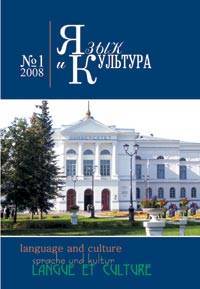Three-stage model of using the tags cloud and concept maps in the educational process of working with English texts
The article focuses on the issue of efficiency of interconnection of the lead pedagogical technologies and education. The aim of the article is to prove that concept-mapping helps high-school students to learn better. The English language has been chosen to be a subject under analysis due to its importance in the studying process and according to future plans of making it an obligatory State exam. Major methods described in the article are experiment, theoretical analysis and ranking. Concept mapping is marked as a useful method for learning a topic of the given discipline. The results are the testing of the methodology for using concept maps in the process of learning the topic for speaking. The essence of the stages mentioned in the title of the article consists in the gradual work on the thesaurus of the studying topic, then on the syntactic and semantic links between the concepts, and, finally, on the construction of the utterances. The topic that has been chosen for conducting an experiment is headlined "Travelling", which is a great opportunity for students to share their thoughts with a teacher. This topic is included in all students' books, and can be found practically at every stage of education: in primary school, in high school and even during university course, which gives room for further analysis in the next articles. Web 2.0. service "tags cloud" in combination with concept-maps management software "CmapTools" is a powerful tool for both, studying and teaching language subjects, the major perk being visualization. The developers of the CmapTools program have the corresponding cloud ser-service, but it still doesn't fit the needs of a user, due to its reduced functions. Taking this fact into consideration, the preferable software for concept-maps building is installed on personal computers at home and in schools. It is crucial to see the result on a display, so that we can monitor the progress of a student, point out the most important lexical units, plan correction work. Semantic field analysis is a proper base for studying the aspects not only of one isolated text, but the whole topic. The concept-maps building can be divided into several stages, during the first one we focus on the key question that becomes the center of the semantic field. During the second stage the context is chosen, we pick out the words that organize semantic periphery. Thirdly, the connections are drawn: the concepts form sentences because of the verbs between them. Finally, ranking and supervising, when we decide, what concepts are more important and closer to the center, and what are more distant, supervising means checking the concept-map one more time, adding links, etc. To illustrate the concepts, bookmarks and hyperlinks can be added into the map, allowing students and teachers to get to know the subject better. In the end of the course, the statistics can be taken into consideration, and the plan can be altered for the next group of students, depending on the outcome. During the pedagogical experiment, two groups of students demonstrate entirely different results: the one, working with the concept-maps understands the topic more deeply, while the representatives of the second group, where the additional tasks from the students' book were given to even the odds, isn't that successful. As for conclusions, we can speak about the effectiveness of the pedagogical experiment and the possibility of further studies with the help of concept maps in the process of learning. We also see the perspectives of using Web 2.0 services in the work of students over foreign texts.
Keywords
концепт-карты, облако тегов, трехстадийная модель работы с иноязычными текстами, информационно-коммуникационные технологии в образовании, визуализация знаний, английский язык, цифровые образовательные ресурсы, concept-maps, tags cloud, three-stage model of foreign language texts processing, information and communication technologies in education, knowledge visualization, the English language, digital educational resourcesAuthors
| Name | Organization | |
| Antonov AYu. | Altai State Pedagogical University | sanya.a23@mail.ru |
| Veryaev A.A. | Altai State Pedagogical University | veryaev_aa@mail.ru |
| Kostykova T.A. | Tomsk State University | kostykova@inbox.ru |
| Domansky V.A. | Universita statale della Marina e Flotta del fiume intitolato all'ammiraglio S.O. Makarova | valerii_domanski@mail.ru |
References

Three-stage model of using the tags cloud and concept maps in the educational process of working with English texts | Yazyk i Kultura – Language and Culture. 2017. № 40. DOI: 10.17223/19996195/40/10
